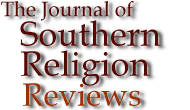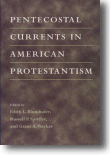


Edith L. Blumhofer, Russell P. Spittler, and Grant A. Wacker, eds. Pentecostal Currents in American Protestantism. Urbana and Chicago: University of Illinois Press, 1999. 273 pp.
![]()
![]()
![]()
The phenomenal growth of "spirit-filled" Christianity in recent years has generated an accompanying increase in scholarly attention. Since about 1970, serious academic studies of Pentecostalism, and the Charismatic renewal it spawned, have grown from a short list of titles to a long shelf of careful, insightful books. Despite the overall quality of this work, however, a certain staleness has come to characterize Pentecostal historiography as the original tasks of discovering the intellectual origins of the movement and detailing the development of its influential leaders and institutions have proven difficult to move beyond. The contributors to Pentecostal Currents in American Protestantism, clearly recognizing these limitations, work hard to break new conceptual and methodological ground by focusing on a variety of "encounters" between mainline Protestants and both the emerging Pentecostal movement in the first half of the twentieth century and the Charismatic revival in the second. As a result, attentive readers will come away from this collection of essays with a lengthy agenda of work that needs to be done.
Edith L. Blumhofer’s cogent introduction provides sufficient glue to hold together twelve often disparate essays, each of which was originally prepared as part of an Institute for the Study of American Evangelicals project called "Mainstream Protestants and the Pentecostal and Charismatic Movements." But even without this overview, one central theme emerges from nearly every essay: The quest for the active, immediate presence of God that characterizes Pentecostal-Charismatic spirituality brings the potential for both vitality and division.
| "African Americans, for example, are almost entirely absent from its pages, and only Schenkel places emphasis on regional variation. But the greatest contribution of this volume lies more in its method than its content." | |
The second major section of the book, "Rethinking Boundaries: Encounters Between the Charismatic Movement and the Protestant Mainstream," opens with a statistical study of 1992 survey data by Corwin E. Smidt, Lyman A. Kellstedt, John C. Green, and James L. Guth that suggests, among other things, the "sense of distance" a majority of Christians feel toward spirit-filled believers, as well as the low level of kinship most Pentecostals and Charismatics perceive with each another. Five suggestive and originally-researched case studies flesh out these relationships. R. Marie Griffith’s study of the Women’s Aglow Fellowship discovers two interesting shifts in the development of the para-church ministry since its 1967 beginning. First, the dominant image of the submissive "helpmeet" has gradually given way to greater emphasis on the cultivation of assertive female "prayer warriors." At the same time, the primary constituency of Aglow has shifted away from Charismatic women who choose to remain in their mainline congregations and toward a membership core of women from Pentecostal denominations and the growing number of independent spirit-filled congregations. In "New Wine and Baptist Wineskins," Albert Frederick Schenkel creates a much-needed narrative of the Charismatic renewal among Baptists through 1980. Furthermore, he points to a marked difference in the reactions of the American and Southern Baptist Conventions (ABC and SBC) to the movement. Nancy L. Eiesland’s essay, "Irreconcilable Differences," examines a Charismatic schism in one Georgia Methodist congregation in light of the mixed messages of encouragement and warning local parishioners received from various denominational agencies and authorities concerning the movement. In another congregational study, Frederick W. Jordan makes effective use of oral history to document the political battles faced by Robert M. Lamont, pastor of the prestigious Presbyterian Church of Pittsburgh, once he befriended Oral Roberts at the Berlin Congress on Evangelism in 1966 and subsequently allowed the unorthodox Pentecostal evangelist Kathryn Kuhlman to use his church’s sanctuary for her weekly healing services. Lastly, in an essay that is sure to provoke debate, Helen Lee Turner finds a "Pentecostal character" in the apocalyptic expectations and prophetic posturing of the conservative leaders who have come to dominate the Southern Baptist Convention over the past two decades (and men, she concedes, hardly known for their sympathies with the Charismatic renewal).
The unsettled portrait of the relationship of the Charismatic movement and the SBC which emerges from this collection will be of special interest to students of religion in the South. Despite the highly publicized involvement of Southern Baptists like Pat Robinson and James Robison in Charismatic ministry, Schenkel finds that SBC members have been far less likely than members of the ABC to participate in the movement, and their preachers have been far more likely to stand in opposition to the spirit-filled experience than their counterparts in the ABC. Also, Schenkel observes that anti-Charismatic rhetoric in the SBC seems to be especially colored by negative stereotypes of traditional Pentecostals. When combined with statistical and anecdotal tidbits presented by other contributors to this volume, the SBC begins to appear peculiarly resistant to Pentecostal-Charismatic encroachments. Yet Turner contends that a key component in the recent success of conservatives within the SBC has been their articulation of a Pentecostal "orientation toward life"--not so much an emphasis on "speaking in tongues and healing," but rather "the belief that the divine is both present and active in the world today" (209). Furthermore, Turner points to the obvious influence of the Charismatic movement on many growing SBC congregations, where the openness of radial seating arrangements and the exuberant singing of "praise choruses" have shifted primary emphasis from the "rational instruction" of hymns and sermons to the "powerful experience" of worshipping a present God in the midst of a community of believers (220-221). The conclusions of Turner and Schenkel are not easily reconciled, and this tension highlights how little we now understand about "Pentecostal currents" in the most prominent southern denomination.
In other ways, Pentecostal Currents in American Protestantism calls students of Pentecostal-Charismatic spirituality in the South to action. African Americans, for example, are almost entirely absent from its pages, and only Schenkel places emphasis on regional variation. But the greatest contribution of this volume lies more in its method than its content. The case study approach successfully illustrates the extent to which the prevailing focus on large institutions and prominent leaders has missed so many complex and interesting stories of the way people live once they (or those they know) are "filled with the Holy Ghost." In particular, the congregational studies by Berends, Eiesland, and Jordan model the value of local history for unearthing the kind of fresh source materials needed to move scholarship beyond the comfortable assumptions of the "big picture." This collection not only breaks new ground; it serves as an invitation to join in the dig.
Daniel Woods, Ferrum College
© 1998-2000 by The Journal of Southern Religion. All rights reserved. ISSN 1094-5234